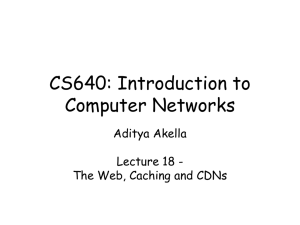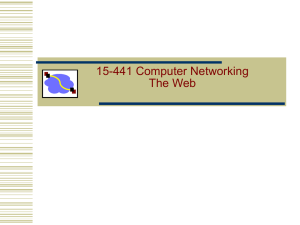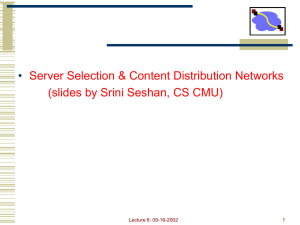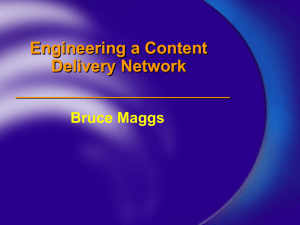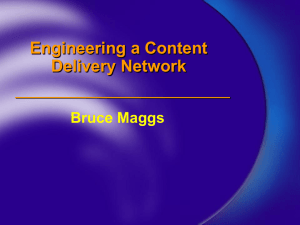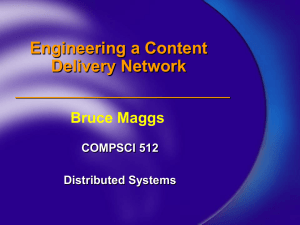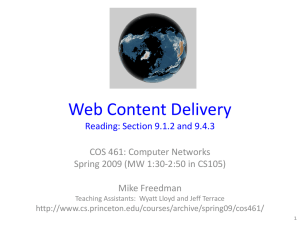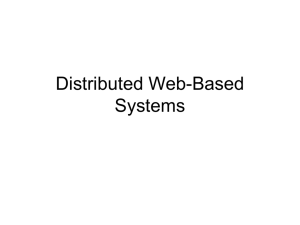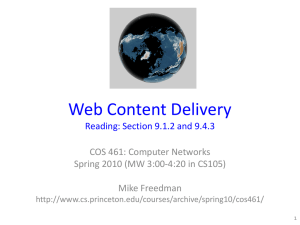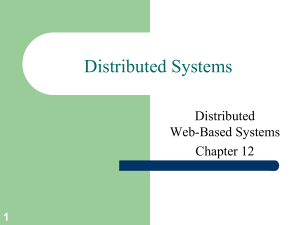15-441 Computer Networking – The Web Lecture 25
advertisement
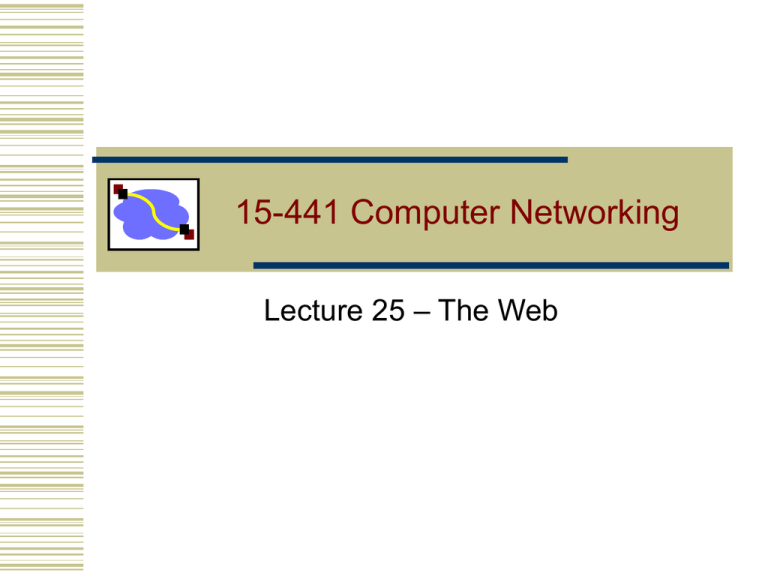
15-441 Computer Networking Lecture 25 – The Web Outline • HTTP review and details (more in notes) • Persistent HTTP review • HTTP caching • Content distribution networks Lecture 19: 2006-11-02 2 HTTP Basics (Review) • HTTP layered over bidirectional byte stream • Almost always TCP • Interaction • Client sends request to server, followed by response from server to client • Requests/responses are encoded in text • Stateless • Server maintains no information about past client requests Lecture 19: 2006-11-02 3 How to Mark End of Message? (Review) • Size of message Content-Length • Must know size of transfer in advance • Delimiter MIME-style Content-Type • Server must “escape” delimiter in content • Close connection • Only server can do this Lecture 19: 2006-11-02 4 HTTP Request (review) • Request line • Method • GET – return URI • HEAD – return headers only of GET response • POST – send data to the server (forms, etc.) • URL (relative) • E.g., /index.html • HTTP version Lecture 19: 2006-11-02 5 HTTP Request (cont.) (review) • Request headers • • • • • Authorization – authentication info Acceptable document types/encodings From – user email If-Modified-Since Referrer – what caused this page to be requested • User-Agent – client software • Blank-line • Body Lecture 19: 2006-11-02 6 HTTP Request (review) Lecture 19: 2006-11-02 7 HTTP Request Example (review) GET / HTTP/1.1 Accept: */* Accept-Language: en-us Accept-Encoding: gzip, deflate User-Agent: Mozilla/4.0 (compatible; MSIE 5.5; Windows NT 5.0) Host: www.intel-iris.net Connection: Keep-Alive Lecture 19: 2006-11-02 8 HTTP Response (review) • Status-line • HTTP version • 3 digit response code • 1XX – informational • 2XX – success • 200 OK • 3XX – redirection • 301 Moved Permanently • 303 Moved Temporarily • 304 Not Modified • 4XX – client error • 404 Not Found • 5XX – server error • 505 HTTP Version Not Supported • Reason phrase Lecture 19: 2006-11-02 9 HTTP Response (cont.) (review) • Headers • • • • • • • • • Location – for redirection Server – server software WWW-Authenticate – request for authentication Allow – list of methods supported (get, head, etc) Content-Encoding – E.g x-gzip Content-Length Content-Type Expires Last-Modified • Blank-line • Body Lecture 19: 2006-11-02 10 HTTP Response Example (review) HTTP/1.1 200 OK Date: Tue, 27 Mar 2001 03:49:38 GMT Server: Apache/1.3.14 (Unix) (Red-Hat/Linux) mod_ssl/2.7.1 OpenSSL/0.9.5a DAV/1.0.2 PHP/4.0.1pl2 mod_perl/1.24 Last-Modified: Mon, 29 Jan 2001 17:54:18 GMT ETag: "7a11f-10ed-3a75ae4a" Accept-Ranges: bytes Content-Length: 4333 Keep-Alive: timeout=15, max=100 Connection: Keep-Alive Content-Type: text/html ….. Lecture 19: 2006-11-02 11 Outline • HTTP intro and details • Persistent HTTP • HTTP caching • Content distribution networks Lecture 19: 2006-11-02 12 Typical Workload (Web Pages) • Multiple (typically small) objects per page • File sizes • Heavy-tailed • Pareto distribution for tail • Lognormal for body of distribution -- For reference/interest only -- • Embedded references • Number of embedded objects = pareto – p(x) = akax-(a+1) Lecture 19: 2006-11-02 13 HTTP 0.9/1.0 (mostly review) • One request/response per TCP connection • Simple to implement • Disadvantages • Multiple connection setups three-way handshake each time • Several extra round trips added to transfer • Multiple slow starts Lecture 19: 2006-11-02 14 Single Transfer Example Client SYN 0 RTT Client opens TCP connection 1 RTT Client sends HTTP request for HTML SYN DAT ACK 2 RTT ACK Server reads from DAT disk FIN ACK Client parses HTML Client opens TCP connection FIN ACK 3 RTT Client sends HTTP request for image 4 RTT SYN SYN ACK DAT ACK Image begins to arrive Server Server reads from disk DAT Lecture 19: 2006-11-02 15 More Problems • Short transfers are hard on TCP • Stuck in slow start • Loss recovery is poor when windows are small • Lots of extra connections • Increases server state/processing • Server also forced to keep TIME_WAIT connection state -- Things to think about -- • Why must server keep these? • Tends to be an order of magnitude greater than # of active connections, why? Lecture 19: 2006-11-02 16 Persistent Connection Solution (review) • Multiplex multiple transfers onto one TCP connection • How to identify requests/responses • Delimiter Server must examine response for delimiter string • Content-length and delimiter Must know size of transfer in advance • Block-based transmission send in multiple length delimited blocks • Store-and-forward wait for entire response and then use content-length • Solution use existing methods and close connection otherwise Lecture 19: 2006-11-02 17 Persistent Connection Example (review) Client 0 RTT Client sends HTTP request for HTML DAT ACK DAT 1 RTT Client parses HTML Client sends HTTP request for image Server Server reads from disk ACK DAT ACK DAT Server reads from disk 2 RTT Image begins to arrive Lecture 19: 2006-11-02 18 Persistent HTTP (review) Nonpersistent HTTP issues: • Requires 2 RTTs per object • OS must work and allocate host resources for each TCP connection • But browsers often open parallel TCP connections to fetch referenced objects Persistent HTTP • Server leaves connection open after sending response • Subsequent HTTP messages between same client/server are sent over connection Persistent without pipelining: • Client issues new request only when previous response has been received • One RTT for each referenced object Persistent with pipelining: • Default in HTTP/1.1 • Client sends requests as soon as it encounters a referenced object • As little as one RTT for all the referenced objects Lecture 19: 2006-11-02 19 Outline • HTTP intro and details • Persistent HTTP -- new stuff -• HTTP caching • Content distribution networks Lecture 19: 2006-11-02 20 HTTP Caching • Clients often cache documents • Challenge: update of documents • If-Modified-Since requests to check • HTTP 0.9/1.0 used just date • HTTP 1.1 has an opaque “entity tag” (could be a file signature, etc.) as well • When/how often should the original be checked for changes? • Check every time? • Check each session? Day? Etc? • Use Expires header • If no Expires, often use Last-Modified as estimate Lecture 19: 2006-11-02 21 Example Cache Check Request GET / HTTP/1.1 Accept: */* Accept-Language: en-us Accept-Encoding: gzip, deflate If-Modified-Since: Mon, 29 Jan 2001 17:54:18 GMT If-None-Match: "7a11f-10ed-3a75ae4a" User-Agent: Mozilla/4.0 (compatible; MSIE 5.5; Windows NT 5.0) Host: www.intel-iris.net Connection: Keep-Alive Lecture 19: 2006-11-02 22 Example Cache Check Response HTTP/1.1 304 Not Modified Date: Tue, 27 Mar 2001 03:50:51 GMT Server: Apache/1.3.14 (Unix) (Red-Hat/Linux) mod_ssl/2.7.1 OpenSSL/0.9.5a DAV/1.0.2 PHP/4.0.1pl2 mod_perl/1.24 Connection: Keep-Alive Keep-Alive: timeout=15, max=100 ETag: "7a11f-10ed-3a75ae4a” Lecture 19: 2006-11-02 23 Ways to cache Client-directed caching: Web Proxies Server-directed caching: Content Delivery Networks (CDNs) Lecture 19: 2006-11-02 24 Web Proxy Caches • User configures browser: Web accesses via cache • Browser sends all HTTP requests to cache origin server Proxy server • Object in cache: cache returns object • Else cache requests object from origin server, then returns object to client client client Lecture 19: 2006-11-02 origin server 25 Caching Example (1) Assumptions • Average object size = 100,000 bits • Avg. request rate from institution’s browser to origin servers = 15/sec • Delay from institutional router to any origin server and back to router = 2 sec Consequences • • • Utilization on LAN = 15% Utilization on access link = 100% Total delay = Internet delay + access delay + LAN delay = 2 sec + minutes + milliseconds origin servers public Internet 1.5 Mbps access link institutional network Lecture 19: 2006-11-02 10 Mbps LAN 26 Caching Example (2) Possible solution • Increase bandwidth of access link to, say, 10 Mbps • origin servers Often a costly upgrade public Internet Consequences • • • Utilization on LAN = 15% Utilization on access link = 15% Total delay = Internet delay + access delay + LAN delay = 2 sec + msecs + msecs 10 Mbps access link institutional network Lecture 19: 2006-11-02 10 Mbps LAN 27 Caching Example (3) Install cache • origin servers Suppose hit rate is .4 Consequence public Internet • 40% requests will be satisfied almost immediately (say 10 msec) • 60% requests satisfied by origin server • Utilization of access link reduced to 60%, resulting in negligible delays • Weighted average of delays = .6*2 sec + .4*10msecs < 1.3 secs 1.5 Mbps access link institutional network 10 Mbps LAN institutional cache Lecture 19: 2006-11-02 28 Problems • Over 50% of all HTTP objects are uncacheable – why? • Not easily solvable • Dynamic data stock prices, scores, web cams • CGI scripts results based on passed parameters • Obvious fixes • SSL encrypted data is not cacheable • Most web clients don’t handle mixed pages well many generic objects transferred with SSL • Cookies results may be based on passed data • Hit metering owner wants to measure # of hits for revenue, etc. • What will be the end result? Lecture 19: 2006-11-02 29 Content Distribution Networks (CDNs) • The content providers are the CDN customers. Content replication • CDN company installs hundreds of CDN servers throughout Internet • Close to users • CDN replicates its customers’ content in CDN servers. When provider updates content, CDN updates servers origin server in North America CDN distribution node CDN server in S. America Lecture 19: 2006-11-02 CDN server in Europe CDN server in Asia 30 Outline • HTTP intro and details • Persistent HTTP • HTTP caching • Content distribution networks Lecture 19: 2006-11-02 31 Content Distribution Networks & Server Selection • Replicate content on many servers • Challenges • • • • • How to replicate content Where to replicate content How to find replicated content How to choose among know replicas How to direct clients towards replica Lecture 19: 2006-11-02 32 Server Selection • Which server? • Lowest load to balance load on servers • Best performance to improve client performance • Based on Geography? RTT? Throughput? Load? • Any alive node to provide fault tolerance • How to direct clients to a particular server? • As part of routing anycast, cluster load balancing • Not covered • As part of application HTTP redirect • As part of naming DNS Lecture 19: 2006-11-02 33 Application Based • HTTP supports simple way to indicate that Web page has moved (30X responses) • Server receives Get request from client • Decides which server is best suited for particular client and object • Returns HTTP redirect to that server • Can make informed application specific decision • May introduce additional overhead multiple connection setup, name lookups, etc. • OK solution in general, but… • HTTP Redirect has some flaws – especially with current browsers • Incurs many delays, which operators may really care about Lecture 19: 2006-11-02 34 Naming Based • Client does DNS name lookup for service • Name server chooses appropriate server address • A-record returned is “best” one for the client • What information can name server base decision on? • Server load/location must be collected • Information in the name lookup request • Name service client typically the local name server for client Lecture 19: 2006-11-02 35 How Akamai Works • Clients fetch html document from primary server • E.g. fetch index.html from cnn.com • URLs for replicated content are replaced in html • E.g. <img src=“http://cnn.com/af/x.gif”> replaced with <img src=“http://a73.g.akamaitech.net/7/23/cnn.com/af/x.gif”> • Client is forced to resolve aXYZ.g.akamaitech.net hostname Lecture 19: 2006-11-02 36 How Akamai Works • • • • How is content replicated? Akamai only replicates static content (*) Modified name contains original file name Akamai server is asked for content • First checks local cache • If not in cache, requests file from primary server and caches file * (At least, the version we’re talking about today. Akamai actually lets sites write code that can run on Akamai’s servers, but that’s a pretty different beast) Lecture 19: 2006-11-02 37 How Akamai Works • Root server gives NS record for akamai.net • Akamai.net name server returns NS record for g.akamaitech.net • Name server chosen to be in region of client’s name server • TTL is large • G.akamaitech.net nameserver chooses server in region • Should try to chose server that has file in cache - How to choose? • Uses aXYZ name and hash • TTL is small why? Lecture 19: 2006-11-02 38 Simple Hashing • Given document XYZ, we need to choose a server to use • Suppose we use modulo • Number servers from 1…n • Place document XYZ on server (XYZ mod n) • What happens when a servers fails? n n-1 • Same if different people have different measures of n • Why might this be bad? Lecture 19: 2006-11-02 39 Consistent Hash • “view” = subset of all hash buckets that are visible • Desired features • Balanced – in any one view, load is equal across buckets • Smoothness – little impact on hash bucket contents when buckets are added/removed • Spread – small set of hash buckets that may hold an object regardless of views • Load – across all views # of objects assigned to hash bucket is small Lecture 19: 2006-11-02 40 Consistent Hash – Example • Construction 0 • Assign each of C hash buckets to 14 n random points on mod 2 circle, Bucket where, hash key size = n. 4 12 • Map object to random position on circle • Hash of object = closest 8 clockwise bucket • Smoothness addition of bucket does not cause movement between existing buckets • Spread & Load small set of buckets that lie near object • Balance no bucket is responsible for large number of objects Lecture 19: 2006-11-02 41 How Akamai Works cnn.com (content provider) DNS root server Akamai server Get foo.jpg 12 Get index. html 1 11 2 5 3 6 7 4 8 Akamai high-level DNS server Akamai low-level DNS server Nearby matching Akamai server 9 End-user 10 Get /cnn.com/foo.jpg Lecture 19: 2006-11-02 42 Akamai – Subsequent Requests cnn.com (content provider) Get index. html 1 DNS root server Akamai server Akamai high-level DNS server 2 7 8 Akamai low-level DNS server Nearby matching Akamai server 9 End-user 10 Get /cnn.com/foo.jpg Lecture 19: 2006-11-02 43 Impact on DNS Usage • DNS is used for server selection more and more • What are reasonable DNS TTLs for this type of use • Typically want to adapt to load changes • Low TTL for A-records what about NS records? • How does this affect caching? • What do the first and subsequent lookup do? Lecture 19: 2006-11-02 44 HTTP (Summary) • Simple text-based file exchange protocol • Support for status/error responses, authentication, client-side state maintenance, cache maintenance • Workloads • Typical documents structure, popularity • Server workload • Interactions with TCP • Connection setup, reliability, state maintenance • Persistent connections • How to improve performance • Persistent connections • Caching • Replication Lecture 19: 2006-11-02 45 Typical Workload (Server) • Popularity • Zipf distribution (P = kr-1) surprisingly common • Obvious optimization caching • Request sizes • In one measurement paper median 1946 bytes, mean 13767 bytes • Why such a difference? Heavy-tailed distribution • Pareto – p(x) = akax-(a+1) • Temporal locality • Modeled as distance into push-down stack • Lognormal distribution of stack distances • Request interarrival • Bursty request patterns Lecture 19: 2006-11-02 47 Caching Proxies – Sources for Misses • Capacity • How large a cache is necessary or equivalent to infinite • On disk vs. in memory typically on disk • Compulsory • First time access to document • Non-cacheable documents • CGI-scripts • Personalized documents (cookies, etc) • Encrypted data (SSL) • Consistency • Document has been updated/expired before reuse • Conflict • No such misses Lecture 19: 2006-11-02 48
